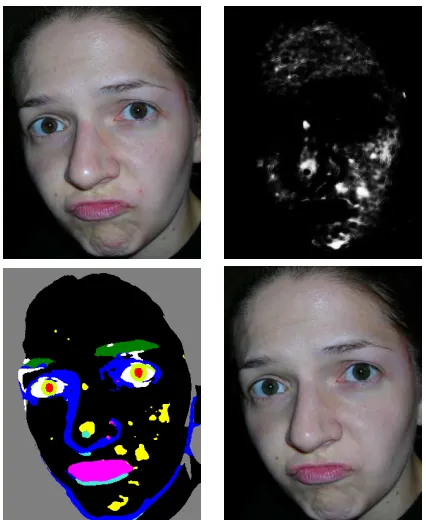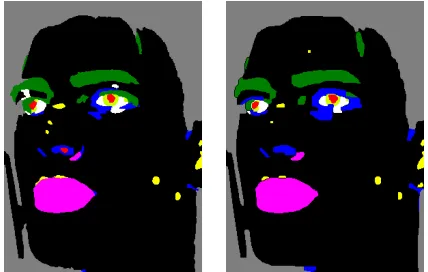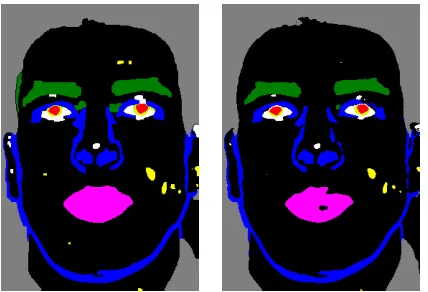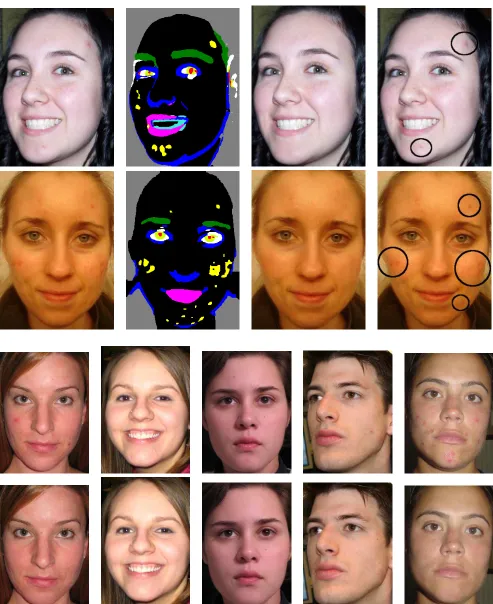MITSUBISHI ELECTRIC RESEARCH LABORATORIES http://www.merl.com
A Conditional Random Field for Automatic
Photo Editing
Matthew Brand, Patrick Pletscher
TR2008-035 July 2008
Abstract
We introduce a method for fully automatic touch-up of face images by making inferences about the structure of the scene and undesirable textures in the image. A distribution over image segmentations and labelings is computed via a conditional random field; this distribution controls the application of various local image transforms to regions in the image. Parameters governing both the labeling and transforms are jointly optimized w.r.t. a training set of before-and-after example images. One major advantage of our formulation is the ability to marginalize over all possible labeling and thus exploit all the information in the distribution; this yield better results than MAP inference. We demonstrate with a system that is trained to correct red-eye, reduce specularities, and remove acne and other blemishes from faces, showing results with test images scavenged from acne-themed internet message boards.
CVPR 2008
This work may not be copied or reproduced in whole or in part for any commercial purpose. Permission to copy in whole or in part without payment of fee is granted for nonprofit educational and research purposes provided that all such whole or partial copies include the following: a notice that such copying is by permission of Mitsubishi Electric Research Laboratories, Inc.; an acknowledgment of the authors and individual contributions to the work; and all applicable portions of the copyright notice. Copying, reproduction, or republishing for any other purpose shall require a license with payment of fee to Mitsubishi Electric Research Laboratories, Inc. All rights reserved.
A conditional random field for automatic photo editing
ETH Institute of Computational Science
8092 Zurich, Switzerland
pletscher@inf.ethz.ch
Abstract
We introduce a method for fully automatic touch-up of face images by making inferences about the structure of the scene and undesirable textures in the image. A distribution over image segmentations and labelings is computed via a conditional random field; this distribution controls the ap-plication of various local image transforms to regions in the image. Parameters governing both the labeling and trans-forms are jointly optimized w.r.t. a training set of before-and-after example images. One major advantage of our formulation is the ability to marginalize over all possible labelings and thus exploit all the information in the distri-bution; this yields better results than MAP inference. We demonstrate with a system that is trained to correct red-eye, reduce specularities, and remove acne and other blemishes from faces, showing results with test images scavenged from acne-themed internet message boards.
1. Overview and Background
Some kinds of photoraphic touch-up, notably red-eye re-duction, have been successfully automated. Other kinds, such as hole repair, are amenable to automatic infill but first require manual segmentation of flaws. Most others, such as blemish and specularity removal, require manual detec-tion and repair, because they ultimately rely on some under-standing of the scene andhow we would wish it to appear. Our goal is to capture this relationship via machine learning and fully automate the work of touch-up inside of a camera. We propose to learn a mapping from a training set of “before” and “after” images, where “after” images contain local image repairs that correct flaws in the scene (e.g., pim-ples) or image acquisition (e.g., specularities). The mapping revolves around a labeling of texture patches in the image as “healthy skin”, “lips”, “acne”, “background”, etc. More precisely, regions of the source image should be labeled according to the kind of repair they need. This approach is related to nonphotorealistic rendering (NPR) and super-resolution (SR) works where inference about the surfaces
constituting an imaged scene is used to calculate how the image would appear with small changes to lighting, view-point, geometry, materials, etc. (e.g., [2, 5, 10, 7, 11]). In these literatures, the source image is divided into patches and a Markov random field (MRF) generates a joint distri-bution over the image and possible labelings of the patches, usually on the basis of patch and label statistics observed in a training set. Parameter estimation and inference inMRFs ranges from hard to NP-hard [1, 13, 6], and it is telling that this approach has been more successful inNPRthan in SR, or, for that matter, image labeling.
In our view, the chief technical problem is that it is un-likely that the true scene can be estimated precisely and reliably, especially from impromptu images snapped by novice photographers using low-quality cameras in unfavor-able lighting. Consequently we cannot expect any inference process to give a single set of reliable repair labels.
Our mathematical framework addresses this problem with three principal contributions: First, our objective seeks a target image that is most likely with respect toallpossible interpretations of the image,i.e., we seek tomarginalize out the labeling. Secondly, we introduce aweak scene grammar
which improves statistical inference and learning (because faces and many other kinds of scenes cannot be assembled arbitrarily). Thirdly, our system learns torecruit repair tex-turefrom elsewhere in the image.
We formulate our system as a discriminatively trained conditional random field (CRF) [8, 12]. UnlikeMRFs,CRFs models the likelihood of the output given the input, not the joint likelihood of the output and the input, thus the repre-sentational capacity of the model is not wasted describing patterns in the training data that are irrelevant to the infer-ence task. Due to the difficulty of training CRFs on cyclic graphs,CRFs have only recently gained traction in computer vision [7, 9, 16, 14]. Our objective adds the challenge of in-tegrating over all labelings. In the reduction to practice, we make this mathematical framework tractable by developing lower bounds on the objective that allow fast inference and learning methods.
In contrast to photo-processing systems that use
(a) input (b) shadow evidence (c) lip/gum evidence (d) most likely classes (e) output
Figure 1. Automatic touch-up applied to an image found on the internet (a). A low-level pixel classifier estimates evidence for 10 classes of image transforms, each specialized for texture classes that roughly correspond to shadowed skin (b), lips/gums (c), eyebrows, sclera, iris, pupils, teeth, background, etc. This evidence is combined with a weak scene grammar and learned statistics of face images in a conditional random field, yielding class likelihoods for each pixel. In this paper, we visually represent the distribution over labellings with a false-color image that indicates, at each pixel site, the label having maximum marginal likelihood (henceforth, maximum-of-marginals). (d). Class likelihoods in turn inform local texture filtering or replacement, here yielding a resynthesized image with red-eye corrected and blemishes removed, but birthmarks preserved (e). The entire process is automatic and trained discriminatively from before-and-after images.
cially engineered heuristics to find and correct each kind of flaw (e.g. [3]) our framework uses no shape or geomet-ric information and performs no search in the image. I.e., the facts that pupils are round and symmetrically arranged about the nose, that lips have corners, etc., play no role in our system. These invariantscouldbe exploited by provid-ing additional evidence features to theCRF, but this paper explores image editing as a purely pixel-level process.
2. Inference Framework
Let source imageX and target imageY be tiled with patches, represented as vectorsxi ∈ Rpandyi ∈ Rq
re-spectively. These may be as small as individual pixels. Each patch can be described with a labelℓi drawn from a finite
setLof repairs. Associated with the tiling is a graph{V,E}
indicating how labelings of adjacent patches might be con-strained by logical or statistical information. A joint label-ingℓℓℓ∈ LN, N =|V|is an assigment of labels to all patches
in an image. We define the score of a labeling as
s(ℓℓℓ|X, θθθ) =X
vectorfi(X)contains feature weights computed for theith
image patch; andθ1, θ2 are parameter matrices. θ1scores
compatibility between a label and evidence;θ2scores
com-patibility between labels at patches that are connected in the graph.
A conditional random field (CRF) [8, 12] is simply a mapping of the score to a normalized probability
distribu-tion over all possible joint labelings of the graph. In our case,
p(ℓℓℓ|X, θθθ) = 1
Z exp s(ℓℓℓ|X, θθθ) (2)
with partition function Z = P
ℓℓℓ′∈LNexp s(ℓℓℓ′|X, θθθ). We
will useθθθhenceforth to refer to all system parameters. We first constrain this distribution to penalize “ungram-matical” scene interpretations—e.g., an eyebrow adjoining teeth—by clamping the relevant parameter to −∞(in re-duction to practice, some constant ≪ 0). These weak “scene grammar” constraints usefully sharpen the distribu-tion over labelings, but do not force face-structured inter-pretations.
We now use this distribution over labelings to build a dis-tribution over synthesized target images. We associate each label with a unique “repair”—a unique local image trans-form that predicts the texture in a target image patch given the corresponding source image patch. In this paper each transform is a (noisy) affine map from local spatial gradi-ents dxi of the source image to those of the target image
(dyi), plus some random additive noiseνννℓ. Thus for each
with learned matrix Wℓ giving the affine transform
asso-ciated with the label ℓ. The distribution ofνννℓ determines
anpredictionlikelihood functionp(dyi|ℓi, dxi, θθθ), whereθθθ
refers to all CRF and transformation parameters. We use
ν ν
νℓ∼ N(0,I), making the prediction likelihood a gaussian
density.
gaussian noise model for the the integration of the target image from its gradients, the conditional likelihood of a tar-get image given source image and labeling is
p(Y|X,L(X), θθθ)∝Y i
p(dyi|ℓi, dxi, θθθ). (4)
Of course, for most source images there is a good deal of uncertainty about the correct labeling, even to human eyes—otherwise, everyone would be a talented touch-up artist. The optimal approach under such uncertainty is to solve for a target image that has greatest conditional like-lihood with respect to the entire distribution of possible image labelings, i.e., we marginalize out the labelings and therefore seek to maximize
In general this calculation is intractable because the sum runs over an exponenial number of labellings. However we can construct a lower bound which allows inference and es-timation to be cast in terms of convex optimization prob-lems: We apply the log-sum inequality to r.h.s. eqn. (5) and rearrange the sums to show that the conditional log-likelihoodp(Y|X, θθθ)is lower-bounded by a weighted sum of the prediction log-likelihoods (errors w.r.t. eqn. 3), where the weights at each patch are precisely the marginal likeli-hoods of the labels at that patch
log X
Thus inference and estimation will revolve around com-puting the label marginalp(ℓi=j|X, θθθ), which is the
con-ditional likelihood of a specific label at a specific patch, marginalized over all possible image labelings. For this there are computationally attractive approximations with bounded suboptimality. Note that the bound tightens when the distribution over labelings p(ℓℓℓ|X, θθθ) has low entropy, and reaches equality (in the unlikely scenario) where the probability mass of theCRFdistribution is concentrated on a single labeling.
Both inference and parameter estimation can be done ef-fectively by maximizing this lower bound on the likelihood of the target image. Indeed, all the problems we discuss below will be addressed as convex optimizations:
Inference: To find the optimal target image Y|X,
equation (6) tells us to choose target patch gradients that
have minimal prediction error logp(dyi|ℓi = j, dxi, θθθ)
with regard to the marginal likelihoods of the patch la-bels. With normally distributedννν, this can be solved in a straightforward sparse least-squares problem where we seek
{yi}i=1...N that minimize the squared difference between
the two sides of equation (3), summing over all patches and labels, and weighted by the label marginals.
Estimation: (transforms) Given paired training images
{X,Y}and label marginals forX, the same system of lin-ear equations can be solved for the optimal affine transforms
{Wℓ}ℓ=1...|L|. This maximizes the lower bound, holding
theCRFparameters fixed.
Estimation:(CRFparameters) Holding the affine
trans-forms fixed, the lower bound is maximized when all the marginal probability mass is concentrated on the transforms giving the least prediction error. Therefore we can increase the lower bound by training the CRFon the discrete label-ing havlabel-ing least prediction error. Formally,p(Y|X, θθθ) ≥
p(Y|ℓℓℓmax,X)p(ℓℓℓmax|X, θθθ)whereℓℓℓmaxis the labeling
giv-ing lowest prediction error of a traingiv-ing pairX,Y accord-ing to eqn. 3. We chooseℓℓℓmaxto maximizep(Y|ℓℓℓmax,X),
then optimizep(ℓℓℓmax|X, θθθ)through any supervised training
method forCRFs,e.g., ascending the gradient
d
dθ2logp(ℓℓℓmax
|X, θθθ) ={heie⊤jip(ℓℓℓmax)=1−heie⊤jip(ℓ|X,θθθ)}ij,
and similarly for θ1, replacing ej with fj(X). Here heiejip(·)is the expectation, under distributionp(·), of the
outer product between the label indicator vectors at any two patches connected in the graph, i.e., it is the marginal pair-wise probabilities of labels i and j over all edges in the graph. The gradient is thus the difference between marginal pairwise statistics of the labels inℓℓℓmax the marginal
pair-wise probabilities in the distribution specified byθθθ. Finally, because our bounding arguments are strongest with low-entropy distributions, we use aL1prior on the
pa-rameters: p(θij)∝e−|θij|, which promotes sparsity in the
compatibility matrices. In gradient ascent this is effected by shifting all free parameters in θ1, θ2 a constant decrement
toward zero on each iteration.
Training proceeds by alternating optimization of the transformation parameters and the CRF parameters. One can train using only “before” (X) and “after” (Y) images. However, we found that first training the CRF matrices
θ1, θ2on “label hint” images considerably speeds the
sub-sequent training of the full system.
Figure 2. In this test image the blemish-detectingSVMhas a strong response over most of the face and nose, including birthmarks and specularities. The CRFdetermines that most of these pixels are more likely to belong to other classes. In the final result the birth-mark is kept; the acne on the forehead, cheek, and chin is removed; and the specularity is moderated.
3. Implementation and Results
Face images were collected from user message board at web site http://acne.org/ with an eye to having a variety of skin types, ages, and complexions. Most are informal self-portraits taken with low resolution phone cams or webcams under generally unfavorable lighting conditions. Poses, lighting, and lens distortions vary widely. From each train-ing image a blemished or unblemished image was made via manual touch-up, as well as a “hint” labeling image. Im-ages were roughly cropped to the head, as can be done by current in-camera face-detectors. To reduce lighting and gamut bias, the colorspace of each image was affinely pro-jected onto PCA axes estimated from pixels in its central region as in [4]. Roughly 25 images were used for training, and 50 for testing. No test individuals appear in the training set.
For convenience of experimentation, we divided the pro-cessing pipeline into three parts: a low-level pixel classifier that yields feature vectors for theCRF; aCRFthat uses these vectors as evidence; and the least-squares solver that com-bines the affine transforms and re-integration of the gradi-ent patches to yield the final predicted image. These are first trained separately on the “before”, “after”, and “label hint” images. They are then combined as a favorable
pa-rameter initialization of equation (5), and jointly improved by alternating estimation ofθ1, θ2and{Wi}to a point of
diminishing returns. In our experiments, 4-8 iterations were needed to obtain good results on the held-out test images.
For the initial low-level classifier, a linear support vec-tor machine (SVM) was estimated to distinguish patches “belonging” to each pair of classes. Each image patch is represented by a vector of oriented multiscale Gabor fil-ter responses, computed in the top two dimensions of the image’s colorspace PCA. Following standard practice for multiclass settings [15], the pairwiseSVMscores (distance of a point from the separating hyperplane, measured as multiples of the margin) are mapped viatanhsigmoids to pseudo-probabilities, which are multiplied to yield the class pseudo-likelihoods. These are then used as evidence in the
CRF. As shown in the response images in figure 1, these are informative but unreliable class indicators.
The CRF parameters were initialized to the pairwise statistics of the labels in the hint images and the low level class pseudo-likelihoods.
To estimate the affine transforms, the source and the tar-get images were moved into the gradient domain by finite differencing, then all target patches belonging to a label in the hint image were affinely regressed onto the correspond-ing source patches, yieldcorrespond-ing class-specific affine transforms. Random nearby patches of source texture with other class labels were also incorporated into the regression, where they were used to the degree that they predict the local tar-get texture better than the local source texture. A parallel process is employed in inference. This allows the system to learn to recruit nearby texture when replacing undesir-ables such as skin sores with healthier looking skin texture. For classes with insufficient samples, the least-squares re-gression was lightly regularized with small diagonal values. We experimented with patch sizes 1×1,2×2,4×4,6×6,
8×8, all giving visually good results, with 6×6 yielding lowest prediction errors. It is interesting to note that averag-ing the label marginals in the1×1CRFover6×6results in marginals extremely close to those of the6×6CRF. For the purposes of illustration, the false-color images in this paper are generated with a1×1patch size CRF.
Thus initialized, the modules were combined and jointly optimized as described in the previous section.
Figure 3. Contextual inference improves over special-purpose classifiers. From left to right, an image with very different lighting than those of the training set; the class-specific response images of the multiclassSVM. The last three images show the multiclassSVMpixel classification, the more accurateCRF MAPlabeling, and the system output, which uses the full marginal distribution on labels and thus avoids problems with theSVDandCRF MAPlabelings.
the resulting gradients to produce the target image. The inferential parts of this pipeline are illustrated in fig-ure 1. Figfig-ure 2 highlights the role of the CRF in
assess-ing poor evidence. Note that the system correctly distin-guishes pimples from freckles of the same color, remov-ing the former and preservremov-ing the latter. Figure 3 shows that theCRFproduces significantly better labelings than the low-level classifier, but even when both produce flawed la-belings, marginalizing over theCRF’s full distribution yields a good output image. Figure 6 shows several real-world im-ages and their automatic touch-ups. All are test imim-ages, kept out of the training set.
Often, but not always, the MAP and maximum-of-marginals image agree (see figure 5), and give a reason-able segmentation. However, using such “hard” labelings for touch-up generally does not produce results as good as those from the “soft” marginal labeling. Finally, figure 4 shows an example of a blooper—a dark nostril mistaken for a pupil—that was eliminated by the introduction of weak grammatical constraints.
In our experiments, training took less than two hours— relatively quick considering that the model contains a mul-ticlassCRF. Inference took roughly 1/2 minute per photo.
4. Discussion
In this paper we constructed a conditional random field on local signal edits by conditioning a set of parameter-ized continuous local transforms on a multiclass discrete
CRF, then marginalizing out all “hidden” variables by
in-tegrating over all CRF labelings. Marginalization allows us to use all the information in the CRFdistribution. Be-cause the full marginalization is intractable, we developed a lower bound that revolves around node marginals, and
in-Figure 4. A labeling “blooper” (left) where the dark nostril is mis-taken for a pupil and dark skin around the eyes is mismis-taken for eyebrows. A weak scene grammar largely eliminates such mis-takes (right).
ference/estimation procedures that reduce to a small num-ber of convex optimizations in practice. With as little as 10 training images, the system does a good job of removing un-wanted blemishes and imaging artifacts from photographs.
Figure 5. A MAP labeling (left) versus a maximum-of-marginals labeling. The MAP label is slightly smoother, but the two are al-most identical, showing that at the end of training theCRF param-eters and the input induce a low-entropy distribution over scene interpretations.
viable by increasing the training set and classes.
Our current implementation could be improved in a num-ber of ways: One might obtain even better label likelihoods by training the CRFdirectly on image features, instead of multiclassSVMoutputs (at cost of considerably more com-putation). The source-to-target transforms could be con-strained to ignore pixels of foreign source texture (e.g., a hair over the forehead). Additional classes could be in-troduced, for example, to allow different treatment of eye-lashes and eyebrows. A stronger grammar could impose la-beling restrictions to enforce the geometric schema of faces. The system also makes subtle errors, for example, smooth-ing out the corners of the lips because there is nonzero probability mass for the hypothesis that these are pimples. Resolving this will require a larger repertoire of evidence features, particularly those that implicitly carry some infor-mation about whether the observed texture is appropriately located in the geometry of the face. However, these are mainly engineering matters, whereas our goal for this pa-per is to exhibit a simple and minimal system that pa-performs quite well “in the wild” of casual imaging devices and un-controlled imaging conditions.
References
[1] Y. Boykov, O. Veksler, and R. Zabih. Fast approxi-mate energy minimization via graph cuts.IEEE Trans. PAMI, 23(11):1222–1239, 2001.
[2] W. T. Freeman, E. C. Pasztor, and O. T. Carmichael. Learning low-level vision. International Journal of Computer Vision, 40(1):25–47, 2000.
[3] M. Gaubatz and R. Ulichney. Automatic red-eye de-tection and correction.Image Processing, 2002.
[4] D. J. Heeger and J. R. Bergen. Pyramid-based texture analysis/synthesis. InProc. SIGGRAPH, pages 229– 238, 1995.
[5] A. Hertzmann, C. E. Jacobs, N. Oliver, B. Curless, and D. Salesin. Image analogies. InProc. SIGGRAPH, pages 327–340, 2001.
[6] V. Kolmogorov and R. Zabih. What energy functions can be minimized via graph cuts? IEEE Trans. PAMI, 26(2):147–159, 2004.
[7] S. Kumar and M. Hebert. Discriminative fields for modeling spatial dependencies in natural images. In
Proc. NIPS, 2003.
[8] J. Lafferty, A. McCallum, and F. Pereira. Condi-tional random fields: Probabilistic models for seg-menting and labeling sequence data. InProc. ICML, pages 282–289. Morgan Kaufmann, San Francisco, CA, 2001.
[9] A. Quattoni, M. Collins, and T. Darrell. Conditional random fields for object recognition. InProc. NIPS, 2004.
[10] R. Rosales, K. Achan, and B. J. Frey. Unsupervised image translation. In Proc. ICCV, pages 472–478, 2003.
[11] T. A. Stephenson and T. Chen. Adaptive markov random fields for example-based super-resolution of faces. EURASIP Journal on Applied Signal Process-ing, 2006.
[12] C. Sutton and A. McCallum. An introduction to conditional random fields for relational learning. In L. Getoor and B. Taskar, editors,Introduction to Sta-tistical Relational Learning. MIT Press, 2006. [13] M. Wainwright, T. Jaakkola, and A. Willsky. Map
esti-mation via agreement on trees: Message-passing and linear-programming approaches. IEEE Trans. Infor-mation Theory, 51(11):3697–3717, 2005.
[14] J. Winn and J. Shotton. The layout consistent random field. InProc. CVPR, 2006.
[15] T.-F. Wu, C.-J. Lin, and R. C. Weng. Probability es-timates for multi-class classification by pairwise cou-pling.Journal of Machine Learning Research, 5:975– 1005, 2004.
[16] H. Xuming, R. Zemel, and M. Carreira-Perpinan. Multiscale conditional random fields for image label-ing. InProc. CVPR, pages 695–702, 2004.




